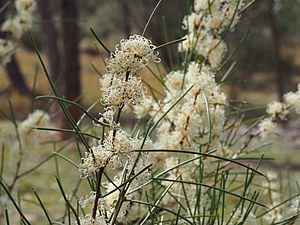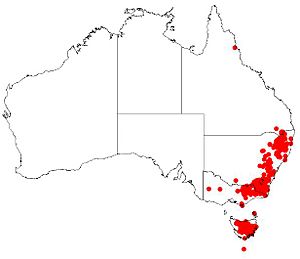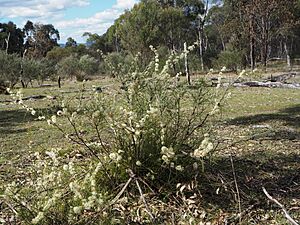Small-fruit hakea facts for kids
Quick facts for kids Small fruit hakea |
|
|---|---|
 |
|
| Hakea microcarpa leaves and flowers | |
| Scientific classification | |
| Genus: |
Hakea
|
| Species: |
microcarpa
|
 |
|
| Occurrence data from AVH | |
The Hakea microcarpa, also known as small-fruit hakea, is a cool flowering plant found only in eastern Australia. It's a type of shrub that spreads out, often growing in forests, open bushy areas called heathlands, and sometimes near swamps. You'll usually spot it in mountain areas. It belongs to a plant family called Proteaceae.
What Does It Look Like?
The small-fruit hakea is a shrub that can grow up to about 2 meters (6.5 feet) tall. Often, it spreads out wider than it is tall. Its leaves and branches are smooth and hairless, except for a few hairs on new growth. These hairs usually disappear by the time the plant flowers.
The leaves are typically shaped like needles, about 3 to 11 centimeters (1 to 4 inches) long and very thin, around 1.5 millimeters (0.06 inches) wide. Sometimes, you might find a few flatter leaves that are up to 5 millimeters (0.2 inches) wide.
The flowers are off-white. They grow in groups of ten to forty where the leaves join the stem (this spot is called a leaf axil). Each flower has a small stalk that is 2 to 5 millimeters (0.08 to 0.2 inches) long. The flower's outer parts, called the perianth, are about 2.5 to 3.5 millimeters (0.1 to 0.14 inches) long.

This plant flowers from September to February. After flowering, it produces fruit. The fruit is a woody pod called a follicle. Inside, there are two seeds that have wings, which help them fly away in the wind. The pod is shaped like an oblong, about 16 millimeters (0.6 inches) long and 7 millimeters (0.3 inches) wide. It has a small point, 2 to 3 millimeters (0.08 to 0.1 inches) long, on each of its two sides.
Naming the Plant
The Hakea microcarpa was first officially described in 1810 by a botanist named Robert Brown. His description was published in a scientific paper called Transactions of the Linnean Society of London.
The second part of its scientific name, microcarpa, comes from two ancient Greek words. Mikros (μικρός) means "small," and karpos (καρπός) means "fruit." So, the name "microcarpa" simply means "small fruit," which makes sense because its fruit pods are quite small!
Where Does It Grow?
The small-fruit hakea grows along the east coast and in the mountain ranges of Australia. You can find it from Stanthorpe in Queensland all the way down to Tasmania. It likes to grow in damp places, such as subalpine bogs (wet, spongy ground), or in forests and woodlands where the soil stays moist.
Images for kids
-
The small-fruit hakea growing in Polblue Swamp, Barrington Tops State Conservation Area, Australia



